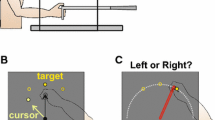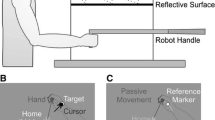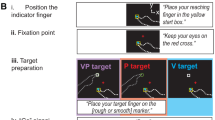Abstract
In the following study, we asked if reaches to proprioceptive targets are updated following reach training with a gradually introduced visuomotor perturbation. Subjects trained to reach with distorted hand-cursor feedback, such that they saw a cursor that was rotated or translated relative to their actual hand movement. Following reach training trials with the cursor, subjects reached to Visual (V), Proprioceptive (P) and Visual + Proprioceptive (VP) targets with no visual feedback of their hand. Comparison of reach endpoints revealed that reaches to VP targets followed similar trends as reaches to P targets, regardless of the training distortion introduced. After reaching with a rotated cursor, subjects adapted their reaches to all target types in a similar manner. However, after reaching with a translated cursor, subjects adapted their reach to V targets only. Taken together, these results show that following training with a visuomotor distortion, subjects primarily rely on proprioceptive information when reaching to VP targets. Furthermore, results indicate that reach adaptation to P targets depends on the distortion presented. Training with a rotation distortion leads to changes in reaches to both V and P targets, while a translation distortion, which introduces a constant discrepancy between visual and proprioceptive estimates of hand position throughout the reach, affects changes to V but not P targets.





Similar content being viewed by others
References
Baraduc P, Wolpert DM (2002) Adaptation to a visuomotor shift depends on the starting posture. J Neurophysiol 88:973–981
Bernier PM, Chua R, Franks IM (2005) Is proprioception calibrated during visually guided movements? Exp Brain Res 167:292–296
Bernier PM, Gauthier GM, Blouin (2007) Evidence for distinct, differentially adaptable sensorimotor transformations for reaches to visual and proprioceptive targets. J Neurophysiol 98:1815–1819
Berniker M, Kording K (2008) Estimating the sources of motor errors for adaptation and generalization. Nat Neurosci 11:1454–1461
Block H, Bastian A (2010) Sensory reweighting in targeted reaching: Effects of conscious effort, error history, and target salience. J Neurophysiol 103:206–217
Block H, Bastian A (2011) Sensory weighting and realignment: independent compensatory processes. J Neurophysiol 106:59–70
Block H, Bastian A (2012) Cerebellar involvement in motor but not sensory adaptation. Neuropsychologia 50(8):1766–1775
Buch ER, Young S, Contreras-Vidal JL (2003) Visuomotor adaptation in normal aging. Learn Memory 10:55–63
Clayton HA, Cressman EK, Henriques DY (2014) The effect of visuomotor adaptation on proprioceptive localization: the contributions of perceptual and motor changes. Exp Brain Res 232:2073–2086
Craske B, Gregg SJ (1966) Prism after-effects: identical results for visual targets and unexposed limb. Nature 212:104–105
Cressman EK, Henriques DY (2009) Sensory recalibration of hand position following visuomotor adaptation. J Neurophysiol 102:3505–3518
Desmurget M, Pelisson D, Rossetti Y, Prablanc C (1998) From eye to hand: planning goal directed movements. Neurosci Biobehav R 22:761–788
Ernst M, Banks M (2002) Humans integrate visual and haptic information in a statistically optimal fashion. Nature 415:429–433
Ernst M, Bulthoff H (2004) Merging the senses into robust percept. Trends Cogn Sci 8:162–169
Flanders M, Tillery SI, Soechting JF (1992) Early stages in a sensorimotor transformation. Behav Brain Sci 15:209–320
Ghahramani Z, Wolpert D, Jordan M (1997) Computational models of sensorimotor integration. Adv Psychol 119:117–147
Harris CS (1963) Adaptation to displaced vision: visual, motor, or proprioceptive change? Science 140:812–813
Harris CS (1965) Perceptual adaptation to inverted, reversed, and displaced Vision. Psychol Rev 72:419–444
Hatada Y, Miall RC, Rossetti Y (2006) Long lasting after-effect of a single prism adaptation: directionally biased shift in proprioception and late onset shift of internal egocentric reference frame. Exp Brain Res 174:189–198
Hay JC, Pick HL Jr (1966) Visual and proprioceptive adaptation to optical displacement of the visual stimulus. J Exp Psychol 71:150–158
Helbig H, Ernst M (2007) Optimal integration of shape information from vision and touch. Exp Brain Res 179:595–606
Jeannerod M (1988) The Neural and Behavioural Organization of Goal-Directed Movements. Clarendon Press, Oxford
Khanafer S, Cressman EK (2014) Sensory integration during reaching: the effects of manipulating visual target availability. Exp Brain Res 232:3833–3846
Kording KP, Wolpert DM (2004) Bayesian integration in sensorimotor learning. Nature 427:244–247
Krakauer JW (2009) Motor learning and consolidation: the case of visuomotor rotation. Adv Exp Med Biol 629:405–421
Krakauer JW, Ghilardi MF, Ghez C (1999) Independent learning of internal models for kinematic and dynamic control of reaching. Nat Neurosci 2:1026–1031
Krakauer JW, Pine ZM, Ghilardi MF, Ghez C (2000) Learning of visuomotor transformations for vectorial planning of reaching trajectories. J Neurosci 20:8916–8924
Martin TA, Keating JG, Goodkin HP, Bastian AJ, Thach WT (1996) Throwing while looking through prisms. II. Specificity and storage of multiple gaze-throw calibrations. Brain 119:1199–1211
Mon-Williams M, Wann J, Jenkinson M, Rushton K (1997) Synaesthesia in the normal limb. Proc Biol Sci 264:1007–1010
Mostafa AA, Salomonczyk D, Cressman EK, Henriques DY (2014) Intermanual transfer and proprioceptive recalibration following training with translated visual feedback of the hand. Exp Brain Res 232:1639–1651
Redding GM, Wallace B (1993) Adaptive coordination and alignment of eye and hand. J Motor Behav 25:75–88
Redding GM, Wallace B (1996) Adaptive spatial alignment and strategic perceptual motor control. J Exp Psychol Hum Percept Perform 22:379–394
Redding GM, Wallace B (2002) Strategic calibration and spatial alignment: A model from prism adaptation. J Motor Behav 33:401–412
Redding GM, Wallace B (2003) Dual prism adaptation: calibration or alignment? J Motor Behav 35:399–408
Redding GM, Rossetti Y, Wallace B (2005) Applications of prism adaptation: a tutorial in theory and method. Neurosci Biobehav R 29:431–444
Reuschel J, Drewing K, Henriques D, Rosler F, Fiehler K (2010) Optimal integration of visual and proprioceptive movement information for the perception of trajectory geometry. Exp Brain Res 201:853–862
Sainburg RL, Wang J (2002) Interlimb transfer of visuomotor rotations: Independence of direction and final position information. Exp Brain Res 145:437–447
Sarlegna F, Sainburg R (2007) The effect of target modality on visual and proprioceptive contributions to the control of movement distance. Exp Brain Res 176:267–280
Simani MC, McGuire LM, Sabes PN (2007) Visual-shift adaptation is composed of separable sensory and task-dependent effects. J Neurophysiol 98:2827–2841
Snijders HJ, Holmes NP, Spence C (2007) Direction-dependent integration of vision and proprioception in reaching under the influence of the mirror illusion. Neuropsychologia 45:496–505
Sober S, Sabes P (2005) Flexible strategies for sensory integration during motor planning. Nat Neurosci 8:490–497
Taylor JA, Ivry RB (2011) Flexible cognitive strategies during motor learning. PLoS Comp Biol 7:e10001096
Taylor JA, Krakauer JW, Ivry RB (2014) Explicit and implicit contributions to learning in a sensorimotor adaptation task. J Neurosci 34:3023–3032
Turnham EJ, Braun DA, Wolpert DM (2012) Facilitation of learning induced by both random and gradual visuomotor task variation. J Neurophysiol 107:1111–1122
van Beers R, Sitting A, van Der Gon D (1996) How humans combine simultaneous proprioceptive and visual position information. Exp Brain Res 111:253–261
van Beers R, Sitting A, van Der Gon J (1998) The precision of proprioceptive position sense. Exp Brain Res 122:367–377
van Beers R, Sitting A, van Der Gon D (1999) Integration of proprioceptive and visual position-information: an experimentally supported model. J Neurophysiol 81:1355–1364
van Beers R, Wolpert D, Haggard P (2002) When feeling is more important than seeing in sensorimotor adaptation. Curr Biol 12:834–837
Vetter P, Goodbody SJ, Wolpert DM (1999) Evidence for an eye-centered spherical representation of the visuomotor map. Neurophysiology 81:935–939
von Helmholtz HEF (1910) Handbuch der physiologischen optik, 3rd edn. Voss, Hamburg [Translated by Southall JPC (1962) Physiological optics, vol 3. Dover, New York]
Wang J, Sainburg RL (2005) Adaptation to visuomotor rotations remaps movement vectors, not final positions. J Neurosci 25:4024–4030
Warren D, Schmitt T (1978) On the plasticity of visual-proprioceptive bias Effects. J Exp Psychol Hum Percept Perform 4:302–310
Wei K, Kording K (2010) Uncertainty of feedback and state estimation determines the speed of motor adaptation. Front Comput Neurosci 4:11
Wolpert DM, Kawato M (1998) Multiple paired forward and inverse models for motor control. Neural Netw 11:1317–1329
Wolpert DM, Ghahramani Z, Jordan MI (1995) An internal model for sensorimotor integration. Science 269:1880–1882
Author information
Authors and Affiliations
Corresponding author
Ethics declarations
Funding
Natural Sciences and Engineering Research Council (EKC).
Rights and permissions
About this article
Cite this article
Flannigan, J.C., Posthuma, R.J., Lombardo, J.N. et al. Adaptation to proprioceptive targets following visuomotor adaptation. Exp Brain Res 236, 419–432 (2018). https://doi.org/10.1007/s00221-017-5141-y
Received:
Accepted:
Published:
Issue Date:
DOI: https://doi.org/10.1007/s00221-017-5141-y




